Before Monad TGE, interpreting the public chain disruptor focused on "high performance + full EVM compatibility."
This article is co-authored by K1 Research and Klein Labs
Key points:
Monad is a Layer 1 public chain focused on “high performance + full EVM compatibility”, having raised over $240 million in total funding, with the mainnet expected to launch by the end of 2025. It is poised to become a disruptor in the public chain space where "performance and compatibility cannot coexist," with its optimistic parallel EVM design as the core technological breakthrough.
Utilizing the “MonadBFT consensus + optimistic parallel EVM” architecture, it can achieve 0.8-1 second single-round finality and 70%-80% parallel execution of transactions, although the performance stability in complex scenarios still needs further validation after the mainnet launch.
Compared to other parallel EVM projects in the same track, Monad has formed a differentiated advantage with “independent Layer 1 architecture + full EVM native compatibility + over $240 million in funding reserves,” demonstrating a performance potential of 0.5 seconds block interval during the testnet phase.
The ecosystem has gathered over 280 projects, with total ecosystem financing reaching $1.32 billion, promoting ecological cold start through hackathons, specialized accelerators, and other support mechanisms, with capital flow concentrated in DeFi infrastructure and core application layers.
With “Builders First” as its core strategy to attract developers, despite facing controversies over mainnet progress and validator decentralization, its ecological friendliness and technological innovation provide support for long-term value. Future efforts need to overcome key issues of delivering on performance commitments and retaining user scale.
1. New Public Chain Star Monad: Background and Development Milestones
1.1 Disruptor Monad: Positioning, Origin, and Vision
Looking back at the development of public chains, Ethereum has built the largest ecosystem due to its EVM compatibility, but performance bottlenecks have always constrained its scalable applications. Solana, representing "high-performance public chains" with ultra-high TPS, has faced a trust crisis due to insufficient decentralization and technical stability issues. The experiences and lessons from these two leading public chains provide a clear reference for Monad's positioning.
Monad was born to address the core pain point in the current public chain track where "performance and compatibility cannot coexist." Its core positioning is as a “Layer 1 public chain that combines extreme performance with complete EVM compatibility.” Unlike some public chains that sacrifice EVM compatibility for performance or compromise performance for EVM compatibility, Monad aims to break this "dilemma" from the ground up—achieving high-performance breakthroughs through innovative consensus mechanisms and execution layer optimizations while maintaining seamless compatibility with Ethereum's EVM, allowing developers to migrate applications to Monad without code reconstruction, and providing users with low-latency, low-cost transaction experiences.
From its origin, Monad directly addresses the real bottlenecks of the Ethereum ecosystem. With the explosive growth of applications like DeFi, NFTs, and GameFi, the Ethereum network frequently experienced TPS below 15, gas fees soaring to tens or even hundreds of dollars, and transaction confirmation delays exceeding 10 minutes during peak periods. For example, during the "bull market" of 2021, the gas fee for a single NFT transaction on OpenSea peaked at $196, forcing ordinary users out of high-frequency trading scenarios; DeFi protocol liquidation transactions often failed due to network congestion, leading to user asset losses. Although Ethereum has alleviated some pressure through Layer 2 scaling solutions, the interaction costs between Layer 2 and the mainnet and the complexity of cross-chain solutions remain fundamentally unresolved. The Monad team consists of engineers with years of experience in blockchain infrastructure development, who have deeply participated in optimizing Ethereum's core protocol and debugging Solana's performance. Its core members are acutely aware that to achieve large-scale commercial use of blockchain, it is essential to tackle the three major challenges of "performance, compatibility, and decentralization" at the Layer 1 level, which has become the core motivation for launching the Monad project.
Monad's long-term vision is not simply to replace an existing public chain but to build a "universal platform" for the next generation of blockchain infrastructure: on one hand, by achieving performance goals of 10,000 TPS, 1-second finality, and average gas fees "below 1 cent," it aims to meet the demands of high-frequency trading, large-scale gaming, and real-time data interaction that Ethereum currently cannot support; on the other hand, relying on complete EVM compatibility, it seeks to attract developers and project resources from the Ethereum ecosystem, forming a "seamless migration, efficient operation" ecological closed loop; ultimately, through a dynamic validator mechanism and distributed storage solutions, it aims to ensure the decentralized nature of the network, allowing ordinary nodes to participate in network maintenance. From a broader perspective, Monad hopes to drive blockchain technology from "niche experimentation" to "mass application," providing foundational support for the digital transformation of traditional industries such as finance, logistics, healthcare, and social networking, truly realizing the industry vision of "empowering the real economy with high-performance blockchain."
1.2 A Visual Overview! Monad's "Growth Surge" Timeline

From this timeline, it is clear that Monad's "star halo" is not accidental but a result of the synergistic efforts of capital support, talent strength, and technological implementation capability:
In terms of financing, Monad has successfully attracted continuous support from top industry capital due to its clear technical positioning and broad development prospects. In 2023, it completed a $19 million seed round led by Dragonfly Capital, and in 2024, it secured $225 million led by Paradigm, with total funding exceeding $240 million. Notable institutions such as Coinbase Ventures and Electric Capital are among the investors, and the project's valuation has risen to $3 billion, laying a solid financial foundation for technological breakthroughs, team expansion, and ecological layout.
On the team level, core members come from leading financial and technology institutions such as Jump Trading and Goldman Sachs, possessing deep expertise in distributed system design and low-latency trading optimization. Some members have also deeply participated in the iteration of Ethereum's core protocol and performance debugging of Solana, providing key support for the project to overcome the industry pain points of "performance - compatibility - decentralization" with their professional technical background.
In terms of technological implementation, the performance during the testnet phase further confirms its potential—after launch, peak TPS reached 5200, processing over 334 million RPC requests within 12 hours, and the total number of on-chain addresses exceeded 300 million, not only validating the feasibility and stability of core technologies such as parallel EVM and MonadBFT but also demonstrating strong appeal to users and developers.
The organic combination of capital, talent, and technological implementation capability has collectively formed the core driving force behind Monad's rapid development in the public chain space, allowing it to stand out in fierce competition.
1.3 Uncertainty and Future Outlook
Although Monad faces some challenges during its development, these challenges also provide opportunities for the project to refine its technology and promote ecological growth. Currently, the uncertainties surrounding Monad mainly focus on the mainnet launch timeline, changes in user activity, and the efficiency of funding utilization. However, as the testnet continues to operate, the gradual rollout of the mainnet will clarify the project's progress and potential. The community's doubts are more based on differences in expectations and typical issues at an early stage rather than fatal flaws in the project itself.
In the future, when monitoring Monad's development, we should not only closely observe whether its promised high-performance goals can be fulfilled on time but also pay special attention to the progress of technological delivery, the effectiveness of decentralized execution, and the actual implementation of ecological construction. As the mainnet launch approaches, these factors will determine Monad's true competitiveness in the public chain field.
Subsequent analyses will delve into network data and operational metrics, technical deconstruction, competitive landscape and advantage analysis, ecological development, and community culture and builder motivations to comprehensively assess its development potential and long-term risks.
2. Network Data and Operational Metrics
2.1 Performance Metrics
Transaction Throughput and Success Rate: The Monad Testnet Overview Dashboard shows that as of the end of August 2025, the testnet has processed approximately 255 million successful transactions, with an average success rate of 98.18% over the past 90 days. Institutional validator Twinstake's nodes achieved 100% block production rate and 100% block proposal rate in Testnet-2, with an average block production rate of about 98.75%, indicating stable consensus efficiency under high-performance goals.
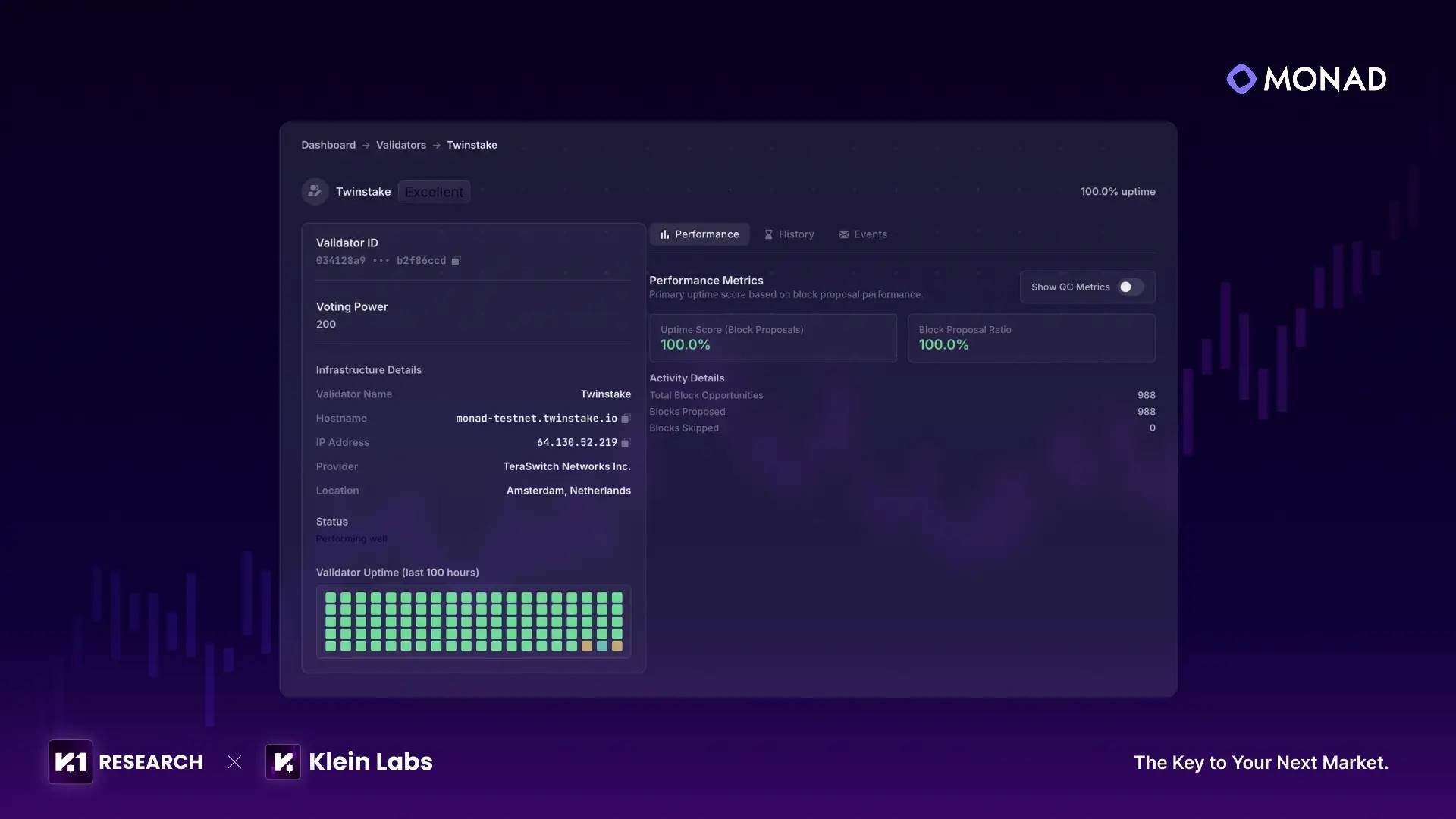
Source: Twinstake | Monad in the Wild: Institutional Insights from Testnet Deployment
● TPS and Fees: The dashboard shows that peak TPS reached 300–350 TPS during March-April 2025 (with a weekly average of about 100 TPS), indicating a gap between actual throughput and the claimed theoretical value of 10,000 TPS; the median transaction fee over the past 90 days was approximately 0.0028 MON.
● Block Delay: Although the dashboard does not directly provide the average block time, the stable transaction throughput without widespread failures between June and July 2025 suggests that block intervals are maintained at sub-second levels, validating the stability of the testnet's parallel execution architecture.
2.2 On-Chain Data
● Address and Wallet Activity: The Monad Foundation's dashboard reports 310,630,141 unique addresses. The BlockRaptor dashboard defines "active wallets" as addresses that have made at least one successful transaction, calculating approximately 309,903,696 active wallets, with an average of 7 transactions per wallet.
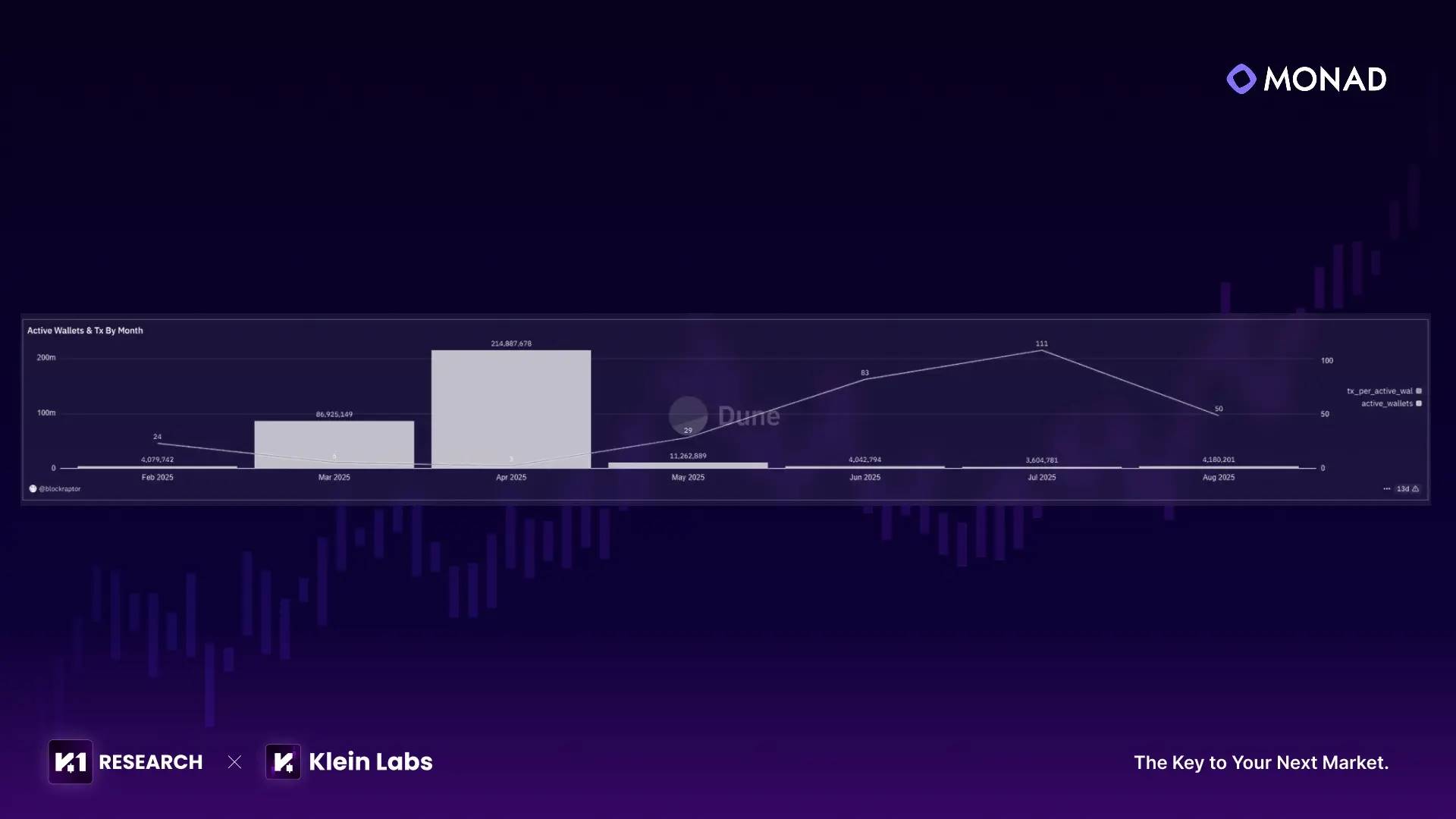
Source: https://dune.com/monad_foundation/monad-testnet-overview-dashboard
● Transaction Distribution and Temporal Evolution: The "Active Wallets & Tx By Month" chart from BlockRaptor shows a significant "spike and drop" characteristic in testnet user growth: active wallets in March were 86.92 million, surging to 215 million in April, then dropping to 11.28 million in May, and stabilizing at around 4 million from June to August; corresponding monthly transaction counts per wallet fell from 6 in March to 3 in April, then rebounded to ranges of 29, 83, and 111 after May. This data reveals that the massive registrations driven by "airdrop expectations" in the early stages did not translate into sustained activity.
● Smart Contracts and Contract Creators: The official dashboard shows that as of the end of August, a total of 36,108,124 contracts have been deployed, created by 2,975,837 contract creators. The BlockRaptor dashboard found that the number of contracts created peaked in March-April (with 60,000 to 80,000 new contracts each month), then declined, but the cumulative number continued to grow steadily.
● Wallet Behavior Distribution: The BlockRaptor dashboard provides a breakdown of active wallets by transaction count each month: in April, 209.5 million wallets made only one transaction, accounting for 97.5% of the total active wallets that month; only 0.9% of wallets executed more than 10 transactions within the month. Overall, by August, 293,597,158 of all active wallets had only transacted once, approximately 89%, further indicating that testnet users are predominantly short-term "participatory" users.
2.3 Decentralization Status
● Validator Nodes and Contract Creators: Currently, there are about 186 active validators on the Monad testnet. From the validator table, it can be seen that all validators have a uniform staking amount of 200 units, with success rates generally close to 100%, demonstrating strong consistency. Validators come from various countries, including Romania, Germany, Ireland, South Korea, and Singapore. This indicates that Monad has achieved a preliminary balance between performance and decentralization, leaving room for expanding the validator scale in the mainnet phase.
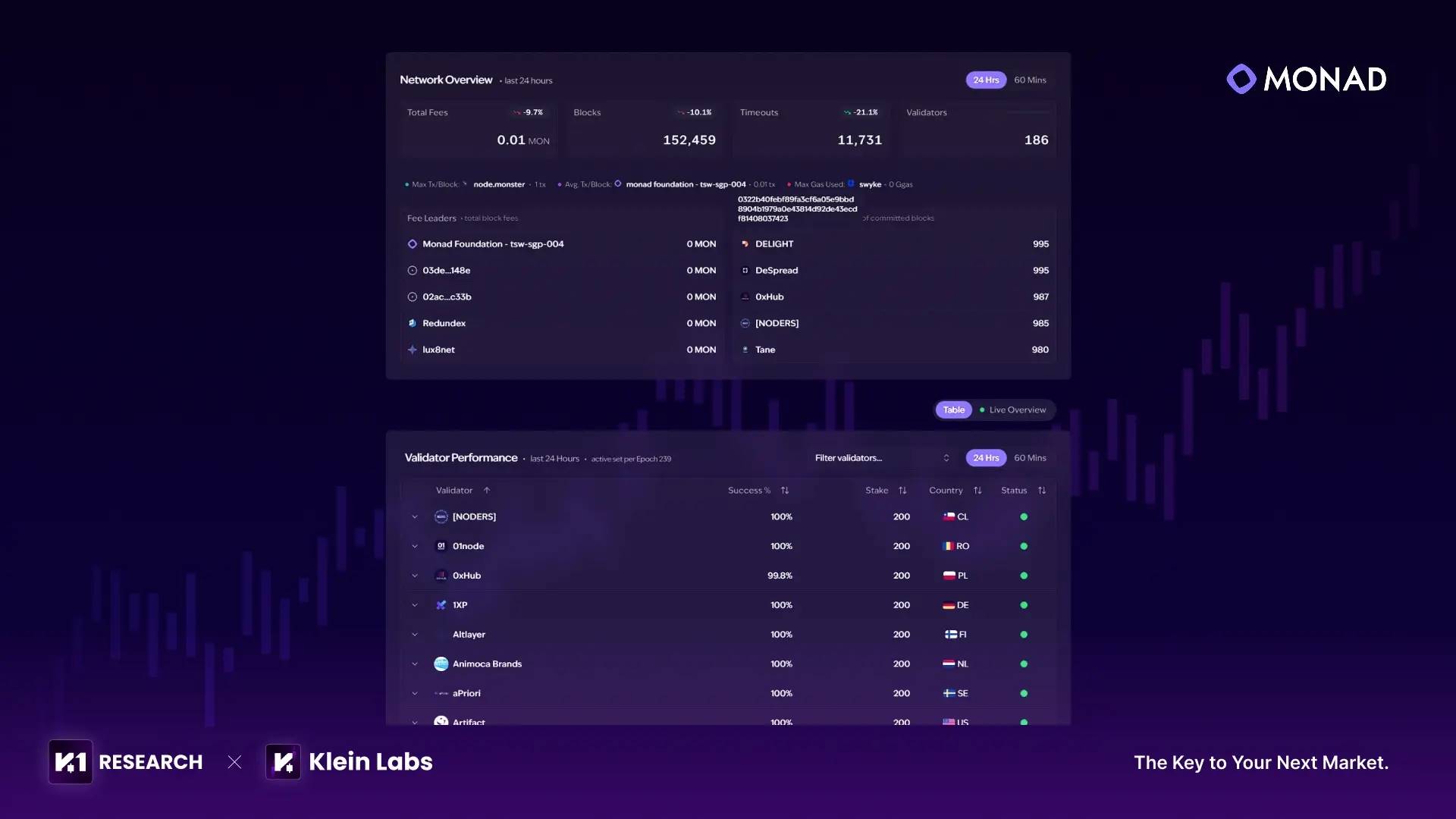
Source: https://www.gmonads.com/validators
From the comprehensive data on Monad's testnet regarding performance, user participation, and developer activity: billions of accumulated transactions and over 300 million active wallets reflect early market interest, but user stickiness and genuine activity levels are relatively low; on average, only a few users maintain high-frequency trading each month, with a transaction success rate stable above 98% and extremely low transaction fees, indicating that the core technical architecture can support high loads but is still in the ramp-up phase.
3. Technical Deconstruction
3.1 Consensus Layer: MonadBFT—Making High-Performance Consensus More Reliable
One of the core reasons Monad can achieve high performance is its self-developed MonadBFT consensus mechanism. It is based on the improvements to the HotStuff consensus from 2018, addressing the congestion issue of traditional BFT protocols (like PBFT) when there are too many messages and fixing the common "tail fork" vulnerability in HotStuff, laying the foundation for the high performance of the entire chain.
3.1.1 Four Core Innovations of MonadBFT
Tail Fork Prevention: A new leader must first re-propose the last valid block, and only when a majority of validators "have not seen that block" can a new block be proposed, ensuring that valid blocks are not lost;
Fast Confirmation: A single vote constitutes "basic confirmation" of a transaction, completed within hundreds of milliseconds, and will not roll back unless the proposer violates the rules;
Flexible Response: No fixed block time is set; consensus is completed in 200-300 milliseconds, with quick switching in case of leader failure;
Scalability: Validators communicate unidirectionally with the leader, allowing hundreds of nodes to participate without affecting performance.
3.1.2 Comparison with HotStuff Family Protocols
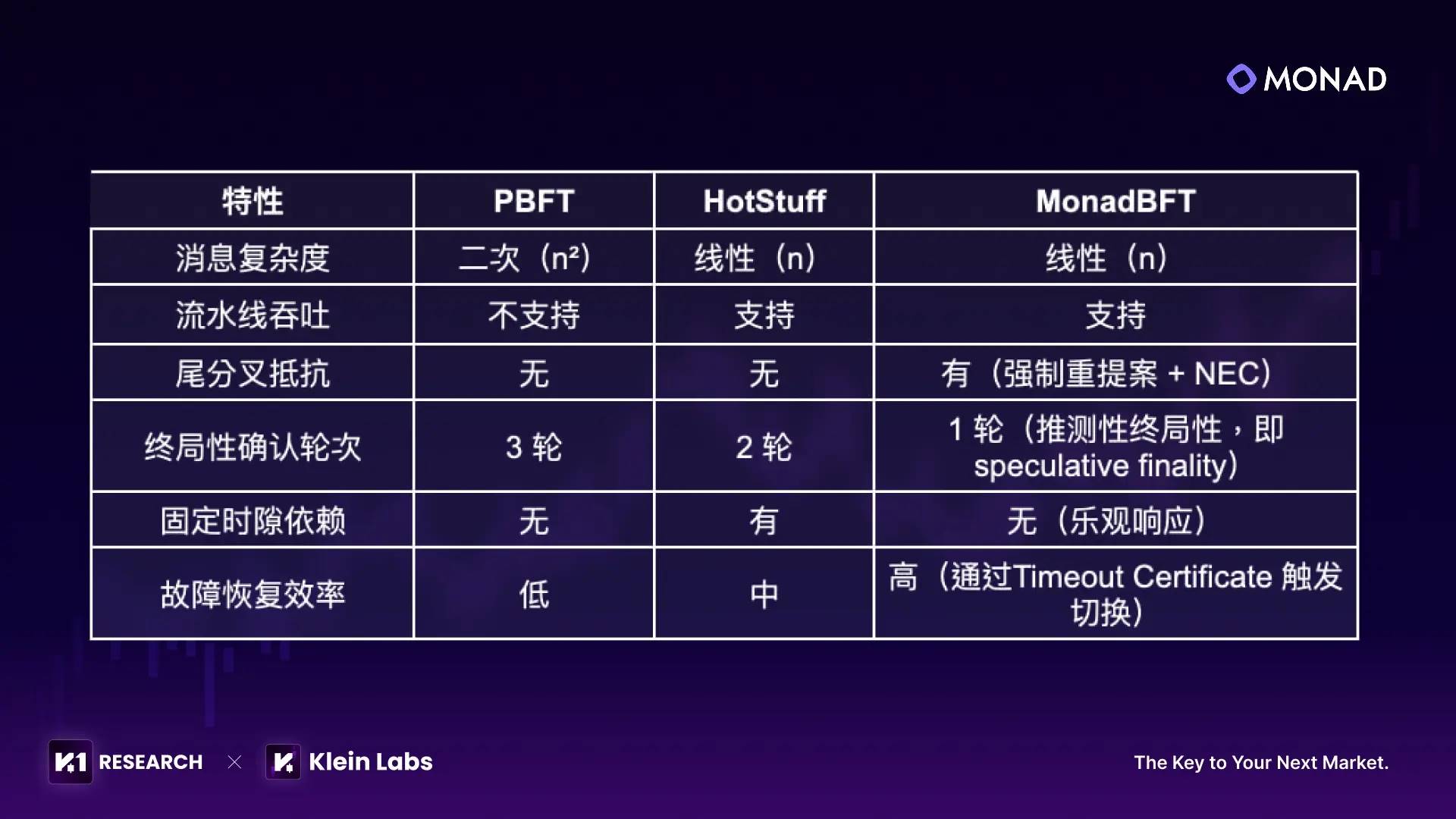
3.2 Execution Layer: Optimistic Parallel EVM—Achieving Compatibility and Performance
Monad's execution layer employs an optimistic parallel EVM, which is fully compatible with the Ethereum EVM ecosystem while breaking through performance bottlenecks through parallel processing.
3.2.1 Core Positioning: Leveraging "Full Compatibility" to Capture Ecological Dividends
It supports the latest Ethereum instructions and pre-built functions, allowing existing contracts to be deployed without modification, and commonly used tools (like Hardhat, MetaMask) can connect directly, significantly reducing the migration costs for developers.
3.2.2 Technical Breakthrough: Optimistic Parallel Execution and Conflict Rollback Mechanism
Monad enhances efficiency through an "execute first, verify later" optimistic parallel mechanism: it groups unrelated transactions for parallel processing, and if transactions modify the same data, it rolls back conflicting results and re-runs them in order. Tests show that 70%-80% of transactions can be processed in parallel, with DeFi scenario efficiency being 8-10 times that of Ethereum.
3.2.3 Differentiated Advantages Compared to Ethereum Rollups
3.3 Technical Synergy Value: Objective Perspective on Advantages and Realistic Considerations
The consensus layer and execution layer of Monad attempt to break the "performance, compatibility, decentralization" dilemma of public chains through technical synergy, but its actual value needs to be viewed objectively in conjunction with technical characteristics and implementation challenges.
3.3.1 Verified Core Advantages: Addressing Clear Industry Pain Points
From the performance of the testnet and technical design, Monad's technical combination has already demonstrated targeted improvement value:
● User Experience: Transaction confirmation has been compressed from "minute-level" to "millisecond-level," with gas fees only 1/20 to 1/30 of Ethereum's, balancing speed and stability;
● Developer Friendly: Zero migration costs provide possibilities for high-frequency trading, chain games, and other applications that Ethereum struggles to support;
● Ecological Capture: Directly connecting to Ethereum's $52 billion TVL and vast developer resources accelerates ecological maturity.
3.3.2 Observational Realistic Challenges: Uncertainties in Technical Implementation
● Performance in Complex Transaction Scenarios: Needs mainnet validation for processing efficiency of multiple cross-dependent transactions;
● Validator Decentralization: Balancing the participation threshold for ordinary nodes with consensus efficiency;
● Ecological Differentiation: Attracting Ethereum Layer 2 developers to migrate and strengthening scenario advantages.
4. Competitive Landscape and Advantage Analysis
4.1 Core Public Chain Performance and Ecological Comparison: Monad & MegaETH & BSC & Sei
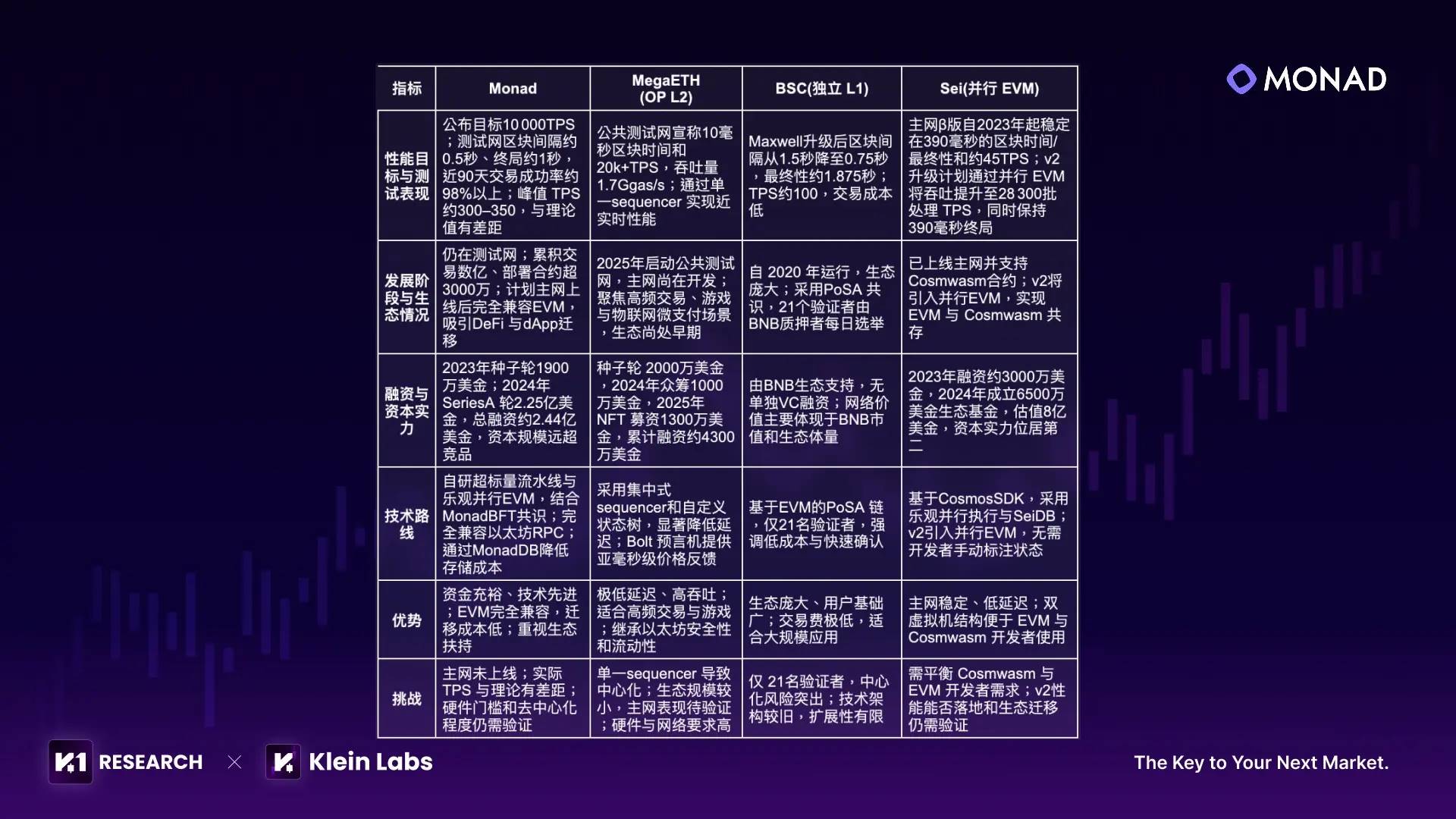
4.2 Comprehensive Review: Monad's Core Competitiveness and Breakthrough Challenges in the High-Performance EVM Public Chain Track
In the differentiated competition of the high-performance EVM track, Monad has significant advantages in capital strength, technical route, and ecological compatibility, laying a solid foundation for its rapid growth in the track.
Core Barriers in Track Competition
Dual Moat of Capital and Ecological Migration: Monad has raised approximately $244 million, far exceeding MegaETH (about $43 million) and Sei, providing strong support for technical development and ecological launch. More importantly, Monad offers an almost zero-cost contract migration path with 100% compatibility at the bytecode level with Ethereum: developers do not need to rewrite contracts, and users do not need to change wallets or habits. This feature significantly lowers the barrier for the ecosystem to migrate from Ethereum to Monad, giving it the potential to quickly gather DeFi and dApp projects.
Performance Positioning Advantage of Independent Public Chain: As an independent L1, Monad adopts its self-developed MonadBFT consensus and optimistic parallel EVM, targeting a throughput of 5,000–10,000 TPS and performance goals of 0.8-1 second finality, striving to achieve high performance without sacrificing decentralization. In contrast, MegaETH pursues sub-millisecond latency through a single sequencer but faces significant centralization controversies; BSC's PoSA model has only 21 validators, limiting its degree of decentralization; Sei v2 can provide batch throughput of 28k+ TPS but still needs validation on the mainnet. Monad's positioning makes it more attractive in scenarios requiring independent security boundaries.
In summary, with ample capital, complete EVM compatibility, and high-performance positioning as an independent public chain, Monad has established a clear advantage in the high-performance EVM track. If it can successfully deliver on performance goals, enhance decentralization, and cultivate an application ecosystem, it is likely to become a benchmark for "high performance + full compatibility" independent public chains.
5. Ecological Development
5.1 Ecological Capital Dynamics: Leading Projects Favored by Top-Tier Capital
As a new generation Layer 1 public chain with cumulative financing exceeding $240 million and a valuation surpassing $3 billion, Monad's capital attractiveness also extends to the ecological level. Its leading ecological projects have received intensive support from top-tier institutions such as Pantera Capital and Binance Labs, injecting strong momentum into the ecological cold start.
Currently, Monad's ecological projects are primarily focused on seed and angel rounds, with capital enthusiasm concentrated in areas characterized by "strong technical adaptability and clear application scenarios." The following will outline representative projects within the ecosystem across multiple tracks, showcasing their diversified layout features.
5.2 Ecological Expansion: Portal Acquisition and Stablecoin Layout
In July 2025, the Monad Foundation completed the acquisition of Portal, marking a key step in Monad's strategic layout in the stablecoin and payment infrastructure sectors. Portal is a company that provides cross-chain stablecoin wallets and payment solutions, and its platform is now capable of supporting daily settlements of stablecoins worth millions of dollars through this acquisition.
The strategic significance of this acquisition by the Monad Foundation includes:
Rapid entry into the stablecoin market, reducing reliance on external stablecoins;
Strengthening the underlying financial infrastructure to provide reliable support for DeFi, payment, and trading scenarios;
Sending a signal to the ecosystem about the focus on developing stablecoins and payment scenarios through direct investment from the foundation.
Overall, the Portal acquisition is not only a capital investment but also a forward-looking layout by Monad in the financial infrastructure and stablecoin ecosystem before the mainnet launch, providing solid support for the subsequent implementation of DeFi and payment scenarios.
5.3 Ecological Scale: Layout Prototype and Growth Potential Before Mainnet
According to official statistics from Monad in 2025, its official ecological directory has included nearly 280 projects, covering diverse fields such as DeFi, infrastructure, AI, gaming, payment, and DePIN, forming a layout characterized by "full track coverage and prominent key areas."
It is noteworthy that although the mainnet has not yet officially launched, Monad has attracted a large number of high-quality entrepreneurial teams due to its technical advantages of "high performance (high throughput, low latency) + full EVM compatibility," combined with the industry influence of top-tier capital backing. The ecological system has gradually transitioned from the early "concept incubation" stage to a critical preparation period of "application function testing and scenario refinement"—for example, several core applications in the DeFi field have completed testnet iterations, and infrastructure projects have also achieved initial adaptation to the ecosystem, laying a solid foundation for rapid growth in user scale and transaction volume after the mainnet launch.
5.4 Ecological Composition: Multi-Track Project Matrix and Core Cases
The Monad ecosystem presents a pattern of "DeFi as the core, with multi-track collaborative extension": DeFi projects lead with a quantity of 12, becoming the most active core track in the ecosystem; wallets serve as the key entry point for users to access the ecosystem, gathering 4 projects; at the same time, "infrastructure-type" tracks such as identity, data analytics, and infrastructure, as well as innovative tracks like AI and prediction markets, have also seen project implementations, reflecting the ecosystem's expansion logic from "core financial scenarios" to "underlying support + diversified applications."
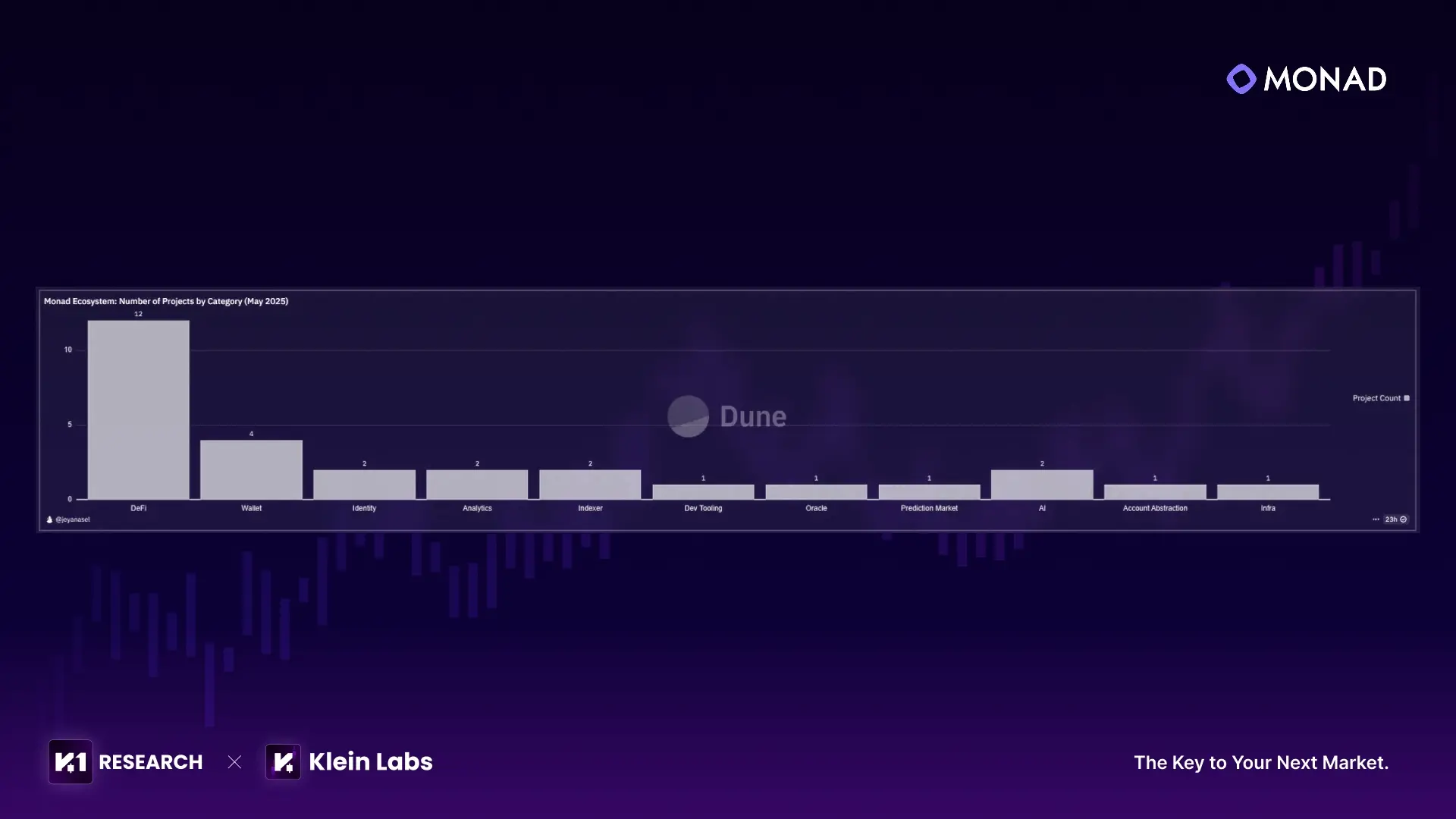
Source: Monad
Combining financing dynamics with official support focuses, the following highlights core projects in the Monad ecosystem that are capital-intensive and officially promoted, analyzing the development potential and implementation progress of each track.
5.4.1 DeFi Infrastructure and Core Applications (Capital-Intensive Area)
- aPriori (@apr_labs)
● Financing: Seed round + strategic investment totaling over $30 million (led by Pantera Capital, with participation from Yzi Labs).
● Positioning: MEV-optimized LSD derivatives platform, focusing on Monad's native staking ecosystem.
● Highlights: Reduces gas costs by over 30% through MEV capture technology, supporting the issuance of various types of staking derivatives; receives key support from the Monad Foundation's "Fundraising & Foundry Program," making it a "benchmark project" in the ecosystem's DeFi sector.
- Fastlane Labs (@0xFastLane)
● Financing: Strategic round of $6 million (led by Figment Capital and DBA) and seed round of $2.3 million (led by Multicoin Capital).
● Positioning: Provider of low-latency trading execution optimization solutions.
● Highlights: Compresses trade confirmation delays to sub-millisecond levels, suitable for high-frequency quantitative and derivatives trading; customizes trading packaging logic for MonadBFT consensus, serving as the "performance foundation" infrastructure in the ecosystem.
- Kintsu (@KintsuFinance)
● Financing: Seed round of $4 million (led by Castle Island Ventures).
● Positioning: Liquidity staking service platform.
● Highlights: Supports staking of Monad's native tokens and multi-chain assets, deeply integrated with the Monad consensus mechanism to ensure the security and yield efficiency of staked assets; a core project in the "Staking layer" of the Monad ecosystem.
- Curvance (@Curvance)
● Support: Received the "Ecological Pioneer" label from Monad during the testnet phase, ranking in the top 3 for community enthusiasm.
● Positioning: Multi-chain lending market (focusing on the Monad mainnet).
● Highlights: Supports lending of over 15 types of assets, leveraging Monad's low gas advantage, with borrowing rates 40% lower than Ethereum Layer 2; user numbers exceeded 100,000 during the testnet phase, expected to become the ecosystem's "lending hub" after the mainnet launch.
- Perpl (@perpltrade)
● Financing: Strategic/seed round of approximately $9.25 million (led by Dragonfly).
● Positioning: Decentralized perpetual contract exchange (perps DEX) built on the Monad chain, using EVM architecture and planning to implement an on-chain central limit order book (CLOB) mechanism.
● Highlights: ① Plans to launch the testnet by the end of the year, allowing users to try it out early and help identify bugs; ② Utilizes Monad's low latency + EVM compatibility to enhance trading experience and compliance speed (token launches may be faster than traditional trading platforms); ③ Concentrates all liquidity in perpetual contracts rather than spreading it across multiple expiration months (unlike options with multiple expiration contracts), enhancing liquidity depth and trading experience.
- Modus Finance (@Modus_Finance)
● Positioning: DeFi lending protocol with high capital efficiency and composability, supporting LST, LRT, LP tokens, and stablecoins.
● Highlights: Offers lending capabilities of up to 95% LTV, enhancing leverage and asset utilization efficiency; reduces systemic risk through a modular market and supports automated leverage strategies (Looping Vault), helping users maximize returns, particularly suited for Monad ecosystem reward assets.
5.4.2 Infrastructure and User Entry Points
- Monorail (@monorail_xyz)
● Positioning: DEX aggregator (integrating AMM and CLOB liquidity).
● Highlights: The first "full-type DEX aggregator" supporting the Monad ecosystem, capable of routing optimal prices from CLOBs and AMMs like Kuru and CrystalExch, reducing slippage by 20% compared to a single DEX; processed over 50,000 transactions daily during the testnet phase.
- Kuru Exchange (@KuruExchange)
● Financing: Series A of $11.6 million (original seed round of $2 million led by Electric Capital, followed by Paradigm leading the completion of Series A financing).
● Positioning: Adjusted its business by launching the Kuru Flow smart aggregator, retaining an order book integrated with AMM, and capable of connecting to all major liquidity sources on Monad, aiming to become the best spot trading venue on Monad.
● Highlights: Adopts a dual architecture of "account custody + Uniswap-style Lite mode," balancing professional trading and novice users; it is one of the largest DEXs by trading volume in the ecosystem.
- Clober (@CloberDEX)
● Positioning: Full-chain order book DEX based on the LOBSTER mechanism (native to Monad).
● Highlights: Utilizes a Segment Tree LOBSTER matching engine and self-developed Octopus Heap data structure, significantly reducing matching gas costs and improving efficiency; the asynchronous settlement mechanism decouples trading from funds, optimizing on-chain execution performance.
5.4.3 Innovative Scenarios and Niche Tracks
- CrystalExch (@CrystalExch)
● Positioning: The first on-chain CLOB exchange in the EVM ecosystem (native to Monad).
● Highlights: The order book is fully on-chain, with transparency comparable to centralized exchanges; leveraging Monad's high throughput, matching speed is 10 times faster than Ethereum's CLOB.
- Zona Finance (@zona_io)
● Positioning: RWA (Real World Assets) super application.
● Highlights: Supports on-chain prediction, lending, and trading of RWAs such as real estate and commodities; combined with Monad's low latency characteristics, RWA price oracle update speed reaches "second-level," making it a core attempt to "link traditional finance" in the ecosystem.
- Levr Bet (@Levr_Bet)
● Support: Awarded the "Most Innovative Project" at the "Monad Madness" hackathon.
● Positioning: Decentralized leveraged sports betting platform.
● Highlights: Offers 5x leveraged sports betting, achieving "on-chain fair settlement" through smart contracts; during the testnet phase, it partnered with data providers for NBA, Premier League, and other events, setting a benchmark in the ecosystem's "Web3 sports" track.
- Plato2Earn (@plato2earn)
● Positioning: "Eat-to-Earn" platform.
● Highlights: Users can upload receipts after spending at partner restaurants to earn $FAT token rewards; combined with Monad's low-cost features, on-chain reward settlement gas fees are less than 1 cent, making it an innovative case of "real life + on-chain" integration in the ecosystem.
- RareBetSports (@RareBetSports)
● Positioning: Daily fantasy sports platform (Web3 version of DraftKings).
● Highlights: Users create on-chain fantasy sports teams and participate in event predictions through token incentives; during the testnet phase, API data cooperation was established with the NFL and MLB, ranking in the top 5 for "most anticipated mainnet launch projects" in community voting.
- Kizzy Mobile (@kizzymobile)
● Positioning: Social betting and mobile entertainment application (native to Monad ecosystem).
● Highlights: Users can make predictions and bets on social media content and receive rewards through on-chain smart contracts; combined with Monad's low cost and high throughput features, users can instantly receive rewards on-chain through mobile spending; it is an important practical case of "real life + blockchain" integration in the ecosystem.
5.4.4 Community Culture and Chain Games
- Nad.fun (@naddotfun)
● Positioning: Meme coin launchpad (Monad version of Pumpfun).
● Highlights: Supports users in issuing custom meme coins, with built-in "PVP trading competitions"; deeply integrated with Monad community "meme culture" (frequent secondary creation coins like mascot molandak, chog), creating a community heat record of a single coin rising 1000 times in 24 hours during the testnet phase.
- Fantasy (@fantasytop)
● Support: Winner of the "Best Chain Game Award" at the "Monad Madness" hackathon.
● Positioning: On-chain card competitive game.
● Highlights: Combines NFT cards with DeFi staking mechanisms, allowing users to earn whitelist NFTs through competitions; over 50,000 users in the first week of the testnet launch, making it a core project in the "GameFi + DeFi" integration of the ecosystem.
6. Community Culture and Builder Motivation
6.1 For Builders: Full-Link Empowerment and First-Mover Opportunities
Monad's core strategy is "Builders First," distinguishing itself from traditional public chain logic that is investor-oriented. By integrating "capital-resources-technology-traffic," it forms a comprehensive support system, creating a "Founder Magnet" effect that provides early projects with a low-competition, high-growth development environment, which is key to its rapid ecological expansion.
6.1.1 Full-Cycle Support: "Close Escort" from Concept to Implementation
To lower the entry barrier for developers, Monad has built a support system covering the entire project lifecycle, deeply integrating the original ecological driving plan into builder services:
● Capital and Resource Matching: Through the "Foundry Program," it integrates capital resources, market channels, and product strategy guidance to help projects advance from the concept stage to product-market fit (PMF), such as connecting early DeFi projects with institutions like Pantera Capital and Binance Labs;
● Technical Support: Provides a complete EVM-compatible toolchain, SDK, and developer documentation to ensure "zero-cost migration" for Ethereum developers; also collaborates with organizations like Mach Accelerator and evm/accathon to launch specialized accelerators, matching teams with experienced mentors in distributed systems, smart contract optimization, and other fields to resolve technical bottlenecks;
● Traffic and Exposure Activation: Hosts the "Monad Madness" hackathon (with a prize pool of up to one million dollars), focusing on high-performance public chain adaptation scenarios (such as high-frequency trading, real-time chain games), attracting hundreds of teams globally to participate, with winning projects receiving community traffic and ecological resource support.
6.1.2 Core Attraction: Overlapping Technical Dividends and First-Mover Advantages
Builders choose Monad, essentially recognizing the dual value of "technical performance" and "ecological opportunities":
● Technical Performance Dividends: The "MonadBFT consensus + optimistic parallel EVM" architecture achieves second-level finality and a throughput target of over 10,000 TPS on a fully EVM-compatible basis, supporting scenarios such as high-frequency trading, complex DeFi, and real-time chain games that Ethereum struggles to accommodate;
● Ecological First-Mover Opportunities: Drawing on the early ecological rise of Magic Eden and Tensor based on Solana, Monad developers generally see the value of "pre-mainnet layout"—initially low traffic competition on the mainnet allows projects to quickly occupy niche track entrances (such as becoming the first order book DEX in the ecosystem or the first liquidity staking platform), even defining track standards. This "first-mover dividend" is difficult for mature ecosystems (like Ethereum and Solana) to provide.
6.2 For Community Users: Refined Operations and Inclusive Co-Building
Monad is not limited to "developer services," but instead, through refined user operations and inclusive community strategies, it fosters user consensus, even transforming "doubters" into community members, creating unique community vitality.
6.2.1 Monad Card: Peer-to-Peer Activation of Core Users and FOMO Effect
During the ecological operation period in 2025, the Monad team launched the "Monad Card" operation activity, becoming a key node for community enthusiasm explosion:
● Precise Screening of Core Groups: The team manually screened about 5,000 influential users (including blockchain OGs, developers, KOLs, investors, etc.) from over 10,000 X (formerly Twitter) accounts, granting exclusive Monad cards in a peer-to-peer manner to strengthen their identity recognition;
● Nomination Mechanism Triggers FOMO: Cardholders can nominate others, creating a layer diffusion effect. Non-cardholders actively participate in testnet interactions and project feedback to compete for eligibility, boosting community activity by three times and significantly enhancing testnet user retention;
● Inclusive Strategy Transforms Doubters: The team intentionally included critics and skeptics in the card issuance range, allowing them to shift from "external questioning" to "internal suggestions" due to identity recognition, even participating in governance discussions to achieve "reducing opposition and expanding consensus."
6.2.2 Community Tension and Transparent Communication
Currently, there is still a tension in the Monad community between "enthusiastic anticipation and rational skepticism," but this tension has become a driving force for community activity:
● Supporters' Perspective: Recognize the combination of "EVM compatibility + high performance," viewing it as the next-generation public chain benchmark that "fills the compatibility gap of Solana and breaks through the performance bottleneck of Ethereum";
● Skeptics' Focus: Concentrate on the mainnet launch progress, the efficiency of using massive financing, and potential centralization issues caused by validator hardware thresholds;
● Team Response: Maintains transparent communication through regular technical reports (such as RaptorCast papers, Testnet-2 progress), monthly AMAs, and public validator rules, gradually building community trust.
6.3 Summary: The Bidirectional Growth Logic of the Ecosystem
The core of the Monad ecosystem lies in the bidirectional strategy of being "friendly to builders and refined for users": providing builders with full-cycle support and dual dividends of technology and first-mover advantages, while designing refined operational mechanisms and an inclusive community atmosphere for users. This strategy avoids the risk of "heavy technology and light ecology" and the short-term trap of "heavy enthusiasm and light service," by solidifying "hard power" (developer empowerment) and "soft power" (user consensus), building long-term growth certainty, making it significantly different from public chains that rely solely on capital or technical narratives.
Reference Links:
Monad: Bringing Back The EVM - ASXN Daily
https://arxiv.org/abs/2502.20692
#73 - Unpacking MonadBFT: Fast, Responsive, Fork-Resistant, Streamlined Consensuschorus.one/articles/solving-blockchains-transaction-bottleneck-how-monad-revolutionizes-evm-transaction-processing
https://mirror.xyz/100y.eth/7_h6gYxMp118ReqlLT-AJ9m59l5geBpmyjDrBIiU3yo
https://www.digitaltoday.co.kr/news/articleView.html?idxno=553932
https://www.digitaltoday.co.kr/news/articleView.html?idxno=588320
免责声明:本文章仅代表作者个人观点,不代表本平台的立场和观点。本文章仅供信息分享,不构成对任何人的任何投资建议。用户与作者之间的任何争议,与本平台无关。如网页中刊载的文章或图片涉及侵权,请提供相关的权利证明和身份证明发送邮件到support@aicoin.com,本平台相关工作人员将会进行核查。





